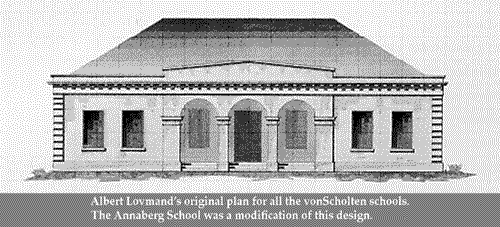The Annaberg School Ruins at Mary’s Creek
The ruins of the Annaberg School at Mary’s Creek are among the most significant historic sites on St. John. Not only are they a wonderful example of uniquely Danish-colonial architecture in the neoclassical style, but they are also a physical representation of the first effort to institute compulsory education throughout the Danish West Indies in 1839. Consequently, that makes the remains of the Territories schools from this period among the oldest public school buildings under the U.S. Flag, and perhaps the oldest in the Western Hemisphere dedicated solely to the compulsory education of African-Americans.
Commonly referred to as vonScholten Schools for Governor-General of the Danish West Indies, Peter vonScholten, who ordered their construction, the schools were to be built to a plan by Danish architect, Albert Lovmand. In all, seventeen schools were originally proposed throughout the colony: eight on St. Croix; five on St. Thomas; and four on St. John. The Annaberg School, however, was the only facility built on St. John to Lovmand’s general design. Scaled down and modified to suit St. John’s smaller population and hilly terrain, the Annaberg School was to provide free, compulsory education to the children of the enslaved laborers on six estates within the Maho Bay Quarter: Cinnamon Bay, Vaniniberg, Munsbery, Annaberg, Mary’s Point, and Leinster Bay.

While another school was built mid-island on the Beverhoudtsberg plantation a few years prior to the Annaberg School, that structure was constructed of wood on a masonry foundation and seems never to have been utilized for its intended purpose. Two other schools were operated on St. John at the Moravian mission stations of Bethany and Emmaus, although, as in the case of the Beverhoudtsberg School, the Lovmand design was not utilized. A fifth smaller school was also erected in this period on St. John’s south side, but details as to the location and duration of its operation remain uncertain. In all cases, Moravian missionaries served as teachers in the schools.
Although construction was well underway on the Annaberg School by 1847, it appears that the building was not fully completed at that time. It was not until August 12, 1856, that Brother J. Gardin penned a report for the Moravian Church periodical announcing the opening of the school:
“In St. Jan we have, this year, opened a school at Annaberg, on the north side of the island. The school-house, which is a very fine one, and is in a charming situation, by the sea, was built many years ago, but never used. There are now twenty-five children in attendance.”
But, while the future of the Annaberg School may have seemed promising in the summer of 1856, staffing the rather remote facility soon proved problematic. Sometime prior to October, 1861, the school was closed after Augustus Knevels was dismissed as schoolmaster on grounds of “gross immorality.” From that date onward, all students from Annaberg were sent to attend school at the Emmaus Mission Station in Coral Bay, and no subsequent teacher was ever engaged to fill Mr. Knevels’s position.
It is generally believed that the Annaberg School was destroyed in the disastrous hurricane and earthquakes that occurred in the fall of 1867. While this might indeed have occurred, no documentation was found to support this conclusion. It may just be that researchers have long presumed that the school was damaged in order to find a logical explanation as to why it was never reopened or utilized for some other purpose at a later date. The truth, however, may not be so simple.
On consideration, it might be that the Annaberg School had simply outlived its usefulness. And, over time, the local population had come to view the site as a relic of their painful past: a reminder of slavery and the harsh constraints of the plantation system. It must be kept in mind that the purpose behind the establishment of the rural schools was to provide limited education for the children of enslaved workers, in a situation that kept those children on, or close, to the estates to which they were bound. With emancipation in 1848, came greater freedom of movement and increased opportunities for open congregation. The dwindling number of workers who remained on St. John’s rural estates quickly embraced self-determination, and they naturally turned to places beyond the boundaries of the plantations to fulfill their spiritual, social, and educational needs. The busy Moravian mission stations of Emmaus and Bethany became more than church settlements, they became the very centers of community life on St. John: school, church, shelter, clinic, meeting house. The movement away from the idea that the plantation was the nucleus of one’s existence was simply too strong to resist. As the missions thrived, the Annaberg School retreated into bush, a failed experiment in amelioration; too little, offered much too late.
[Annaberg][Education]
